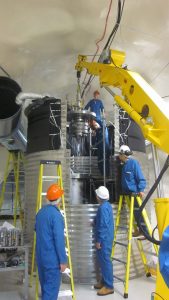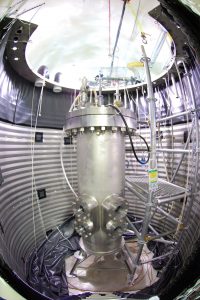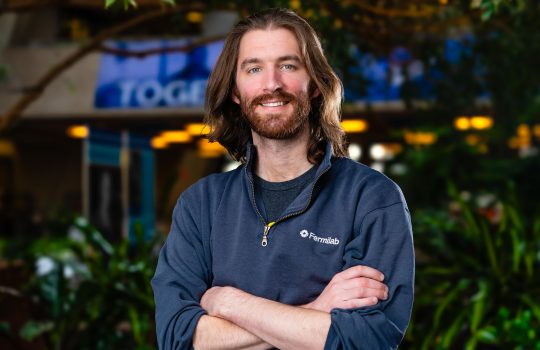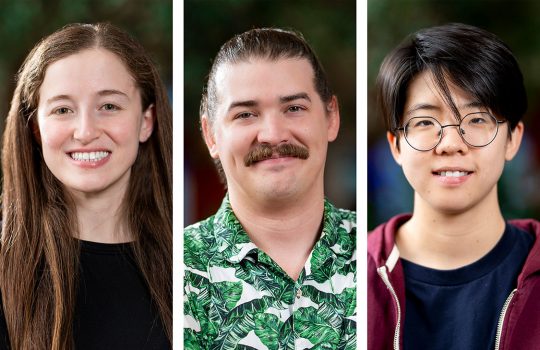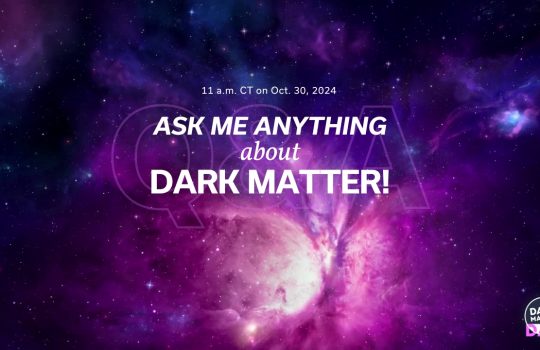Editor’s note: The PICO-60 detector was originally called “COUPP-60,” with COUPP standing for “Chicagoland Observatory for Underground Particle Physics.” It was designed and built by Fermilab in collaboration with the University of Chicago and Indiana University, South Bend. Work began at Fermilab in 2005, and, after extensive testing, the detector was moved to SNOLAB in 2012.
“We’ve been working on this for a long time,” said Fermilab’s project manager Andrew Sonnenschein of the below result. “This is by far our most satisfying result yet, because the techniques we used to reject background events from sources other than dark matter worked flawlessly. Bubble chambers are finally living up to their full potential as dark matter detectors. Now the dark matter just needs to show up.”
Read the original SNOLAB press release on the SNOLAB website.
The PICO Collaboration is excited to announce that the PICO-60 dark matter bubble chamber experiment has produced a new dark matter limit after analysis of data from the most recent run. This new result is a factor of 17 improvement in the limit for spin-dependent WIMP-proton cross-section over the already world-leading limits from PICO-2L run-2 and PICO-60 CF3I run-1 in 2016.
The PICO-60 experiment is currently the world’s largest bubble chamber in operation; it is filled with 45 Liters of C3F8 (octafluoropropane) and is taking data in the ladder lab area of SNOLAB. The detector uses the target fluid in a superheated state such that a dark matter particle interaction with a fluorine nucleus causes the fluid to boil and creates a tell tale bubble in the chamber.
The PICO experiment uses digital cameras to see the bubbles and acoustic pickups to improve the ability to distinguish between dark matter particles and other sources when analysing the data.
The superheated detector technology has been at the forefront of spin-dependent (SD) searches, using various refrigerant targets including CF3I, C4F10 and C2ClF5, and two primary types of detectors: bubble chambers and droplet detectors. PICO is the leading experiment in the direct detection of dark matter for spin-dependent couplings and is developing a much larger version of the experiment with up to 500 kg of active mass.
This work was supported by the the U.S. Department of Energy Office of Science and the U.S. National Science Foundation under Grants PHY-1242637, PHY-0919526, PHY-1205987 and PHY-1506377, and in part by the Kavli Institute for Cosmological Physics at the University of Chicago through grant PHY-1125897, and an endowment from the Kavli Foundation and its founder Fred Kavli. The PICO Collaboration would also like to acknowledge the support of the National Sciences and Engineering Research Council of Canada (NSERC) and the Canada Foundation for Innovation (CFI) for funding.
About PICO
17 participating institutions: University of Alberta; University of Chicago; Czech Technical University; Fermilab; Indiana University South Bend; Kavli Institute for Cosmological Physics; Laurentian University; Université de Montréal; Northeastern Illinois University (NEIU); Northwestern University; Universidad Nacional Autonoma de Mexico; Pacific Northwest National Laboratory; Queen’s University at Kingston; Saha Institute of Nuclear Physics, India; SNOLAB; Universitat Politecnica de Valencia; Virginia Tech.
The PICO Collaboration (formed from the merger of two existing groups, PICASSO and COUPP) uses bubble chambers and superheated fluid to search for dark matter. The PICO-60 detector consists of a fused-silica jar sealed to flexible, stainless steel bellows, all immersed in a pressure vessel filled with hydraulic fluid. Eight lead zirconate (PZT) piezoelectric acoustic transducers mounted to the exterior of the bell jar record the acoustic emissions from bubble nucleation and four 2-megapixel resolution fast CMOS cameras are used to photograph the chamber. The PICO-60 detector was built at Fermilab in Batavia, IL and installed underground at SNOLAB in 2012.
The PICO bubble chambers are made insensitive to electromagnetic interactions by tuning the operating temperatures of the experiment, while the alpha decays are discriminated from dark matter interactions by their sound signal, making these detectors very powerful tools in the search for dark matter.
PICO is operating two detectors deep underground at SNOLAB: PICO-60, a bubble chamber with 52 kg of C3F8 and PICO-2L, another bubble chamber with 2.9 kg of C3F8.
The paper is available on the arXiv.
About SNOLAB
SNOLAB is Canada’s leading edge astroparticle physics research facility located 2 km (6800 ft) underground in the Vale Creighton Mine. The SNOLAB facility was created by an expansion of the underground research areas next to the highly successful Sudbury Neutrino Observatory (SNO) experiment. The entire laboratory is operated as an ultra-clean space to limit local radioactivity. With greater depth and cleanliness than any other international laboratory, it has the lowest background from cosmic rays providing an ideal location for measurements of rare processes that would be otherwise unobservable.
Learn more
Quotes:
“PICO bubble chambers provide the best discrimination against backgrounds of any dark matter detector technology. This pretty much guarantees a continued improvement of sensitivity in upcoming chamber designs. We are still very far from reaching the limits of this technique.”
Juan I. Collar
U.S. spokesperson
Department of Physics
Enrico Fermi Institute
Kavli Institute for Cosmological Physics
“We are extremely excited about these results. Not only have we established a new world-leading limit for dark matter interactions, but we have also demonstrated that with sufficient controls the bubble chamber technology can be run free of backgrounds that could mimic the signal. This bodes very well for the future, as the collaboration is poised to launch a new tonne scale detector based on this technology. This new detector, dubbed PICO 500, will have an order of magnitude greater physics capability and will explore a vast swathe of the parameter space predicted by dark matter theories.”
Tony Noble
Canadian spokesperson
Department of Physics
Queen’s University
For more information, please contact:
Samantha Kuula
Communications officer, SNOLAB
Phone: 705-692-7000 ext. 2222
Email: Samantha.Kuula@snolab.ca
Website: www.snolab.ca
French language contact:
Guillaume Giroux
Postdoctoral fellow, Queen’s University
Email: ggiroux@owl.phy.queensu.ca
Phone: 613-533-6000 ext. 79203
U.S. contact:
Andrew Sonnenschein
Project manager, PICO-60
Fermi National Accelerator Laboratory
Email: sonnensn@fnal.gov
Phone: 630-840-2883

